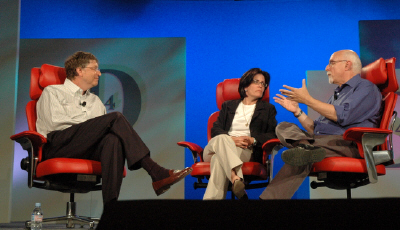Highlight reel from the D conference

The D: All Things Digital (blog posts here) put on by Walt Mossberg and Kara Swisher (with help from WSJ) was a rare event. Of course, the venue (Four Seasons, Carlsbad) and food were good for those who cared, and the attendees included a strange assemblage of well-heeled personalities. The cast, not in order of appearance or affiliation, included Al Gore, Yahoo Terry Semel, MS Bill Gates, Disney Bob Iger, Sony Howard Stringer, San Francisco mayor Gavin Newsom, Earthlink Sky Dayton, Creative Commons Larry Lessig, Symantec John Thompson, film director Barry Sonnefeld, VC Vinod Khosla, Comcast Steve Burke and Kodak Antonio Perez. Many others with lesser titles and/or revenue joined the fun as well. You could see YouTube cofounder Chad Hurley lunching with Martha Stewart or Al Gore with super VC John Doerr or power blogger Arriana Huffington and actor John Cusack.
But it's the content that counts, and Walt and Kara made sure that the guests were properly interrogated. At most conferences there is a fear of making high profile, CEOs suffer with hard questions, but the two Wall Street Journal reporters were fairly relentless in attempting to get straight answers from their subjects.
The Gates Q&A didn't shed many new nuggets, but the Microsoft mogul did come up with a new concept--the reality acquisition device. I still wonder if he actually made it up on the spur of the moment or it came out of some research paper he read last week, but I don't expect to hear much about it in the future.

Al Gore was inspirational in talking about global warming. But at least four Al Gore's surfaced during his hour Q&A with Walt and Kara. First there was the salesman (selling Current.tv and his movie, "An Inconvenient Truth"), the professor (talking about Gutenberg and social history), the passionate environmentalist, and the fiery politician (no, he isn't running he says). If he does end up running, backed by popular demand, he better stick to the rabble rousing environmentalist personality.
Martha Stewart drew applause for her diatribe on having too many power adapters and cables for all her devices. She brought a bag full of cables to the microphone and challenged Sony CEO to fix the problem during a 10 minute performance that was like an episode from her TV show. Stringer responded humorously, first asking for "the check" as if he wanted to make a quick exit, and then telling Martha that she needs a "native bearer" and is like the "little old lady who lives in a shoe." Very funny. Unfortunately, Sir Howard Stringer did not have a solution, but laid some blame on Sony's component division, which has been the most profitable part of the company for the last three years. "It on our list of priorities. If I get invited back I'll find out if I can do anything about it," he said.
Martha's other starring role was teaching a young man how to fold a T-Shirt.
Howard Stringer and film director Barry Sonnefeld get the award for the most humorous interviews. Stringer said that a part of his job running Sony is to eliminate SKUs. "It's exhausting tryng to win on every front and marketing across so many products. Every Sony engineer loves his own product--an electronic toothbrush with a camera..." When talking about the success of Sony's DaVinci Code movie release in comparison to the new X-Men movie, he said Xbox instead of X-Men. Sony's Playstation 3 will compete against the Microsoft's Xbox in a fierce battle. When Walt mentions Steve Jobs, Stringer winces, saying, "It was going so well..."
Sonnefeld, the director of "Get Shorty," the "Men in Black" movies and the recent "RV," is a big fan of the theatrical release, and would rather not see a compressed window that would bring DVDs and VOD sooner. He thought Bill Gates was the "oldest young kid," a "dufus," and he would like to redesign Microsoft's phone user experience. And, Sonnefeld thinks that the Internet and related technologies tend to isolate people. The Internet brings people together in abstract ways, not in a "soulful, karmic way." Yearning for the way it was, when the whole family sat around watching the "Ed Sullivan Show" or "I Love Lucy," instead of playing video games or IMing each other while in the same room.
Terry Semel tried to explain Yahoo's cooperation with the Chinese government is providing information about users, but didn't win over the entire audience with his answers. Disney CEO Bob Iger and Comcast President Steve Burke were prime examples of how established media players plan to leverage the Internet--but they seem more concerned with hanging on to the old way.
As I said earlier, it's all about the content. Not all the interviews were stellar, but in comparison to most conferences, there was some rigor to the discussion, some great performances, good people networking, no Wi-Fi because the hosts want people paying attention (I give thanks for EV-DO so I could overcome that barrier) and a chance to observe the thinking processes of some high-powered CEOs.